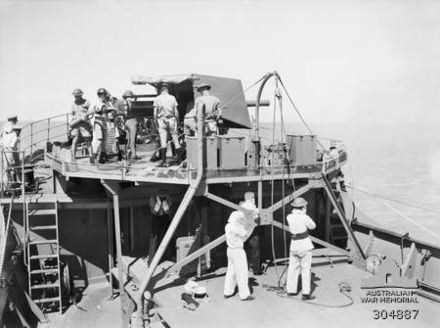| Ordnance QF 4 inch gun Mk IV, XII, XXII | |
|---|---|
 Mk IV gun from HMS Lance at the Imperial War Museum, London | |
| Type | Light Naval gun Submarine gun |
| Place of origin | United Kingdom |
| Service history | |
| In service | 1911-1940s |
| Used by | United Kingdom |
| Wars | World War I World War II |
| Production history | |
| No. built | 1,141 [1] |
| Specifications | |
| Weight | 2,750 pounds (1,250 kg) barrel & breech |
| Barrel length | 160 inches (4.064 m) bore (40 calibres) |
| Shell | Mk IV : Separate QF 31 pounds (14.06 kg); Mk XII & XXII : Fixed QF 31 pounds (14.06 kg), 35 pounds (15.88 kg) from 1944 [2] |
| Calibre | 4-inch (101.6 mm) |
| Breech | horizontal sliding-block |
| Elevation | PIX Mount -10° to +20° CPIII Mount -10° to +30° [1] |
| Muzzle velocity | Mk IV : 2,370 feet per second (720 m/s) [3] Mk XII & XXII : 1,873 feet per second (571 m/s) |
| Maximum firing range | 11,580 yards (10,590 m) at +30° [1] |
The QF 4-inch gun Mk IV [note 1] was the main gun on most Royal Navy and British Empire destroyers in World War I. It was introduced in 1911 as a faster-loading light gun successor to the BL 4 inch Mk VIII gun. Of the 1,141 produced, 939 were still available in 1939. [1] Mk XII and Mk XXII variants armed many British interwar and World War II submarines.

The Royal Navy (RN) is the United Kingdom's naval warfare force. Although warships were used by the English kings from the early medieval period, the first major maritime engagements were fought in the Hundred Years War against the Kingdom of France. The modern Royal Navy traces its origins to the early 16th century; the oldest of the UK's armed services, it is known as the Senior Service.

The British Empire comprised the dominions, colonies, protectorates, mandates and other territories ruled or administered by the United Kingdom and its predecessor states. It originated with the overseas possessions and trading posts established by England between the late 16th and early 18th centuries. At its height, it was the largest empire in history and, for over a century, was the foremost global power. By 1913, the British Empire held sway over 412 million people, 23% of the world population at the time, and by 1920, it covered 35,500,000 km2 (13,700,000 sq mi), 24% of the Earth's total land area. As a result, its political, legal, linguistic and cultural legacy is widespread. At the peak of its power, the phrase "the empire on which the sun never sets" was often used to describe the British Empire, because its expanse around the globe meant that the sun was always shining on at least one of its territories.

In naval terminology, a destroyer is a fast, maneuverable long-endurance warship intended to escort larger vessels in a fleet, convoy or battle group and defend them against smaller powerful short-range attackers. They were originally developed in the late 19th century by Fernando Villaamil for the Spanish Navy as a defense against torpedo boats, and by the time of the Russo-Japanese War in 1904, these "torpedo boat destroyers" (TBDs) were "large, swift, and powerfully armed torpedo boats designed to destroy other torpedo boats". Although the term "destroyer" had been used interchangeably with "TBD" and "torpedo boat destroyer" by navies since 1892, the term "torpedo boat destroyer" had been generally shortened to simply "destroyer" by nearly all navies by the First World War.





























